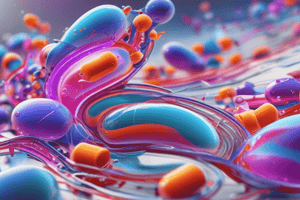Podcast
Questions and Answers
What typically happens when the dose of a drug is increased?
What typically happens when the dose of a drug is increased?
- It eliminates the drug's affinity for its primary target.
- It only enhances the primary effect of the drug.
- It may cause effects on other targets, leading to side effects. (correct)
- It reduces side effects significantly.
Which term describes side effects that occur through the same receptor as the intended effect?
Which term describes side effects that occur through the same receptor as the intended effect?
- Off-target side effects
- Adverse effects
- Synergistic effects
- On-target side effects (correct)
What mechanism leads to drowsiness as a side effect of dimenhydrinate?
What mechanism leads to drowsiness as a side effect of dimenhydrinate?
- Antagonism of serotonin receptors
- Antagonism of muscarinic acetylcholine receptors (correct)
- Inhibition of norepinephrine reuptake
- Agonism of dopamine receptors
What type of activity does diphenhydramine primarily exhibit as a medication?
What type of activity does diphenhydramine primarily exhibit as a medication?
Why are higher doses of a drug more likely to cause off-target side effects?
Why are higher doses of a drug more likely to cause off-target side effects?
What term describes the maximal response that a drug can produce?
What term describes the maximal response that a drug can produce?
How does high potency usually correlate with drug affinity?
How does high potency usually correlate with drug affinity?
Which of the following situations can allow a drug with low affinity to still exhibit high potency?
Which of the following situations can allow a drug with low affinity to still exhibit high potency?
What does the EC50 or ED50 value represent in dose-response studies?
What does the EC50 or ED50 value represent in dose-response studies?
Which factor is NOT mentioned as influencing potency across drugs?
Which factor is NOT mentioned as influencing potency across drugs?
What defines the efficacy of a drug?
What defines the efficacy of a drug?
How is drug potency primarily influenced?
How is drug potency primarily influenced?
What is the term for the concentration or dose required to produce 50% of a drug’s maximal effect?
What is the term for the concentration or dose required to produce 50% of a drug’s maximal effect?
What does a drug with high binding affinity and zero efficacy represent?
What does a drug with high binding affinity and zero efficacy represent?
If Drug A has a pEC50 of 6.0, what is the corresponding EC50 value?
If Drug A has a pEC50 of 6.0, what is the corresponding EC50 value?
Which statement is true about partial agonists?
Which statement is true about partial agonists?
What term is used to describe the logarithmic measure of the concentration needed for a drug's effect?
What term is used to describe the logarithmic measure of the concentration needed for a drug's effect?
Comparing Drugs A and D where Drug A has a lower EC50 than Drug D, which statement is accurate?
Comparing Drugs A and D where Drug A has a lower EC50 than Drug D, which statement is accurate?
What is the primary way that drugs affect enzymes?
What is the primary way that drugs affect enzymes?
Where are receptors and ion channel targets commonly located?
Where are receptors and ion channel targets commonly located?
Which of the following pharmacological effects is associated with changes in mechanical function of cells?
Which of the following pharmacological effects is associated with changes in mechanical function of cells?
Which is true about the target class distribution for drugs?
Which is true about the target class distribution for drugs?
What is meant by drug selectivity?
What is meant by drug selectivity?
Which cellular component must drugs enter in order to act on enzymes?
Which cellular component must drugs enter in order to act on enzymes?
What outcome occurs when chemicals modulate transporter proteins?
What outcome occurs when chemicals modulate transporter proteins?
Which statement about pharmacological targets is correct?
Which statement about pharmacological targets is correct?
What does the EC50 value represent for a partial agonist?
What does the EC50 value represent for a partial agonist?
What occurs if the maximal response to an agonist is lower than the system’s maximal response?
What occurs if the maximal response to an agonist is lower than the system’s maximal response?
How does a higher receptor reserve affect the apparent potency of full agonists?
How does a higher receptor reserve affect the apparent potency of full agonists?
What is a key limitation of concentration-effect curves for full agonist drugs?
What is a key limitation of concentration-effect curves for full agonist drugs?
What is indicated by having spare receptors in a signaling system?
What is indicated by having spare receptors in a signaling system?
Why might the same concentration of an agonist produce different effects in tissues with different receptor reserves?
Why might the same concentration of an agonist produce different effects in tissues with different receptor reserves?
What does it mean if the EC50 approximates KA for binding?
What does it mean if the EC50 approximates KA for binding?
How does the ratio of receptor sites to signaling machinery impact the physiological response?
How does the ratio of receptor sites to signaling machinery impact the physiological response?
What happens to a protein when molecules bind to it during pharmacological interactions?
What happens to a protein when molecules bind to it during pharmacological interactions?
Where are enzymes typically located within a cell for drug interaction?
Where are enzymes typically located within a cell for drug interaction?
How is selectivity defined in relation to drug actions?
How is selectivity defined in relation to drug actions?
What is the primary effect of drugs that target transporter proteins?
What is the primary effect of drugs that target transporter proteins?
Explain how a drug with low affinity can still achieve high potency.
Explain how a drug with low affinity can still achieve high potency.
What indicates that no drug is completely specific in its actions?
What indicates that no drug is completely specific in its actions?
What are the parameters that dose-response curves allow us to estimate?
What are the parameters that dose-response curves allow us to estimate?
What role do second messengers like Ca2+ and cAMP play in pharmacology?
What role do second messengers like Ca2+ and cAMP play in pharmacology?
Why are nuclear receptors unique compared to other drug targets?
Why are nuclear receptors unique compared to other drug targets?
Discuss the relationship between potency and receptor reserve.
Discuss the relationship between potency and receptor reserve.
How can allosteric modulation affect drug efficacy even with low affinity?
How can allosteric modulation affect drug efficacy even with low affinity?
What is the difference between specificity and selectivity in drug interactions?
What is the difference between specificity and selectivity in drug interactions?
Identify and explain two factors, other than affinity, that can influence drug potency.
Identify and explain two factors, other than affinity, that can influence drug potency.
What differentiates an agonist from an antagonist at a receptor site?
What differentiates an agonist from an antagonist at a receptor site?
Define the equilibrium constant $K_A$ and its significance in pharmacology.
Define the equilibrium constant $K_A$ and its significance in pharmacology.
How does the affinity of a drug relate to the value of $K_A$?
How does the affinity of a drug relate to the value of $K_A$?
What occurs when the concentration of a drug equals $K_A$ in terms of receptor occupancy?
What occurs when the concentration of a drug equals $K_A$ in terms of receptor occupancy?
What does the term Emax represent in drug response studies?
What does the term Emax represent in drug response studies?
Explain the role of receptor antagonists in pharmacology.
Explain the role of receptor antagonists in pharmacology.
How does drug concentration affect the biological response in dose-response relationships?
How does drug concentration affect the biological response in dose-response relationships?
Describe the relationship between drug binding and receptor activation based on reversible dynamics.
Describe the relationship between drug binding and receptor activation based on reversible dynamics.
What does it mean if for an antagonist, the parameter β equals 0?
What does it mean if for an antagonist, the parameter β equals 0?
What is the significance of the 'overflow' in the context of dose-response curves?
What is the significance of the 'overflow' in the context of dose-response curves?
What defines the difference between full and partial agonists in terms of efficacy?
What defines the difference between full and partial agonists in terms of efficacy?
What is indicated by a drug with high binding affinity and a low $K_A$?
What is indicated by a drug with high binding affinity and a low $K_A$?
In the context of dose-response curves, what is a characteristic feature of drugs acting on specific targets?
In the context of dose-response curves, what is a characteristic feature of drugs acting on specific targets?
Why is it important to understand the relationship between drug concentration and biological response?
Why is it important to understand the relationship between drug concentration and biological response?
What does a drug with zero efficacy (e = 0) imply about its effects?
What does a drug with zero efficacy (e = 0) imply about its effects?
How are dose-response curves typically plotted and what does this reveal?
How are dose-response curves typically plotted and what does this reveal?
What does the EC50 value represent for a partial agonist?
What does the EC50 value represent for a partial agonist?
Why is it inappropriate to gauge the affinity of full agonist drugs using concentration-effect curves?
Why is it inappropriate to gauge the affinity of full agonist drugs using concentration-effect curves?
What happens when the maximal response to an agonist is lower than the system’s maximal response?
What happens when the maximal response to an agonist is lower than the system’s maximal response?
How does having a higher receptor reserve typically affect the potency of full agonists?
How does having a higher receptor reserve typically affect the potency of full agonists?
In what way can the number of spare receptors affect the physiological outcomes of drug administration?
In what way can the number of spare receptors affect the physiological outcomes of drug administration?
What is the implication of the EC50 value approximating the KA for binding in terms of receptor occupation?
What is the implication of the EC50 value approximating the KA for binding in terms of receptor occupation?
What can be inferred about the difference between concentration applied and that at the receptor in pharmacological studies?
What can be inferred about the difference between concentration applied and that at the receptor in pharmacological studies?
Why is the concept of spare receptors significant in pharmacology?
Why is the concept of spare receptors significant in pharmacology?
Flashcards are hidden until you start studying
Study Notes
Drug Efficacy and Agonists
- Full agonists have maximum efficacy (Emax = 1).
- Partial agonists have intermediate efficacy levels.
- Efficacy indicates a drug's ability to activate receptors after binding, which is crucial for producing biological effects.
Affinity vs. Efficacy
- Affinity determines how well a drug binds to receptors.
- Efficacy measures the drug's ability to activate the receptor upon binding.
- Example: Fentanyl acts as a μ-opioid receptor agonist, demonstrating high efficacy.
- Antagonists, such as naloxone, possess zero efficacy and block receptor activation, particularly at μ-opioid receptors.
Potency
- Defined by both affinity and efficacy; relates to the concentration (EC50) or dose (ED50) needed for 50% of maximal effect.
- A drug's potency is represented on a dose-response curve.
- pEC50 is the negative logarithm of EC50, quantifying potency.
Dose-Response Curves
- Describe the relationship between drug dose and physiological response.
- Drugs may have the same efficacy but differing potencies; for instance, Drug A may have a lower EC50 than Drug D.
Pharmacological Targets
- Drugs can affect receptors, ion channels, enzymes, and transporter proteins.
- Most receptors and channels are located on the cell surface; enzymes are typically found in the cytosol.
Specificity and Selectivity of Drug Action
- Selectivity refers to a drug's ability to preferentially bind to one target over another, while specificity indicates a drug's singular effect across biological systems.
- No drug is entirely specific; increasing doses can lead to unintended effects (side effects).
- Side effects can be classified as "on-target," occurring at the principal receptor, or "off-target," affecting alternative mechanisms.
Side Effects and Mechanisms
- Side effects arise from dose-dependent interactions with unintended targets.
- Dimenhydrinate (antiemetic) demonstrates how a drug can produce desired effects (e.g., nausea relief) while also causing side effects (e.g., drowsiness).
Efficacy vs. Potency
- High potency drugs often have high affinity, enabling significant biological effects at lower concentrations.
- A drug can possess low affinity but high efficacy, allowing maximal effect with minimal receptor occupancy.
Receptor Reserve
- Refers to the surplus of receptor sites available compared to signaling capacity.
- Partial agonists may show variable efficacy across different tissues due to differences in receptor reserve.
- Higher receptor reserves generally increase the apparent potency of full agonists.
Summary of Drug Response Characteristics
- Emax indicates the maximum pharmacological effect of a drug.
- EC50 represents the concentration needed for half-maximal response.
- Concentration-effect curves provide insights into drug potency and receptor interaction, but cannot directly measure full agonist affinity.
Pharmacologic Targets
- Molecules binding to proteins can induce pharmacological effects by changing protein structure.
- Pharmacologic targets include protein receptors, ion channels, enzymes, and transporter proteins, each affecting physiological processes via activation or inhibition.
Location of Targets
- Receptors and ion channels are primarily on the cell surface; enzymes typically reside in the cytosol and require drug penetration.
- Nuclear receptors are exceptions, found within the cell nucleus; DNA also serves as a drug target.
Pharmacological Effects on Cells
- Changes in mechanical functions: enhanced cardiac contractility and contraction of bronchiole smooth muscle.
- Biochemical effects: modulation of second messenger levels (e.g., Ca2+, cAMP).
- Inhibition of enzyme activity affects the degradation rate of cellular messengers like cAMP.
Specificity and Selectivity of Drug Interactions
- Selectivity refers to a drug's ability to preferentially bind specific targets; specificity indicates a drug's isolated effect across biological systems.
- No drug achieves complete specificity or selectivity; interactions depend on drug and target classes.
Agonists and Antagonists
- Agonists activate receptors to elicit tissue responses; antagonists bind to the same receptor site but do not activate it, blocking effects of agonists.
- Receptor ligands encompass both agonists and antagonists.
Binding and Receptor Activation
- Drug binding and receptor activation are reversible processes, influenced by various rate constants.
- Antagonists do not initiate receptor activation (β = 0).
Affinity and Equilibrium Constant (KA)
- KA represents a drug's binding affinity to its receptor; a lower KA indicates higher affinity.
- KA is the concentration required to occupy 50% of receptor sites at equilibrium.
Hill-Langmuir Equation
- The proportion of occupied receptors can be quantified; KA marks the concentration needed for 50% receptor occupancy.
- Binding affinity is inversely related to KA’s value.
Dose-Response Curves
- Biological responses to drugs (e.g., heart rate increase, enzyme activation) are measured and plotted in dose-response curves.
- A consistent increase in response corresponds to escalating drug concentrations.
Efficacy and Potency
- Efficacy (Emax) is the maximum expected effect from a drug.
- Efficacy differentiates full agonists (strong tissue response) from partial agonists (limited response).
Drug Affinity vs. Potency
- High affinity often correlates with potency, allowing significant biological effects at lower concentrations.
- Low-affinity drugs can still achieve high efficacy, producing substantial response with fewer receptors occupied.
Receptor Reserve
- The number of receptor sites can exceed a cell's signaling capacity, allowing significant responses even with low occupancy.
- Variations in receptor reserve between tissues can lead to different physiological outcomes from identical agonist concentrations.
Conclusion
- Understanding pharmacological targets, binding interactions, efficacy, and potency is crucial to drug development and therapeutic applications.
Studying That Suits You
Use AI to generate personalized quizzes and flashcards to suit your learning preferences.



